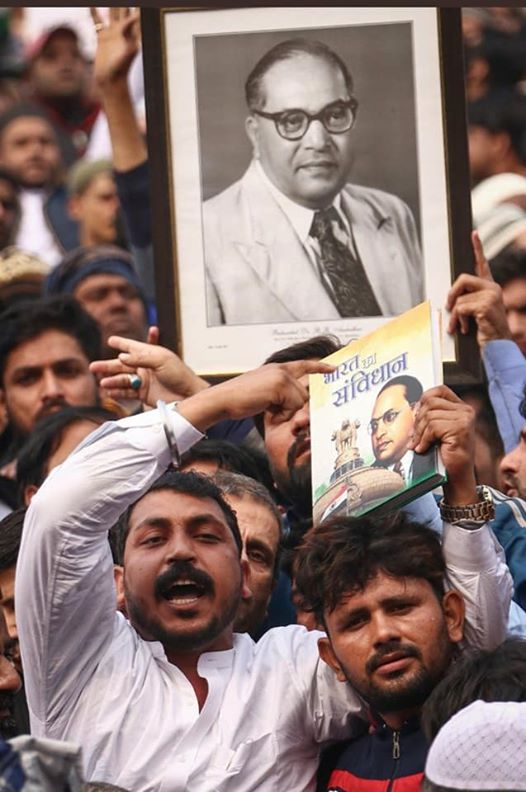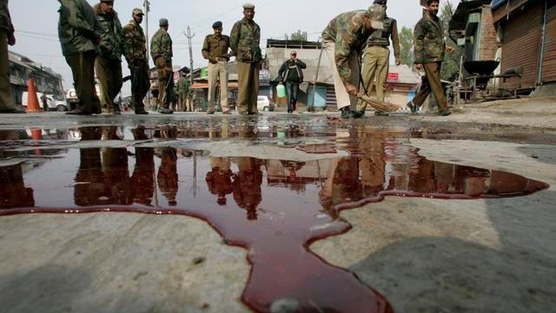Umar Nizar
 Quality vs energy is the major thesis of the Swiss artist Thomas Hirschhorn who held daily workshops at the Kochi-Muziris Biennale in 2018. The ‘meritocratic’ pretensions of third world elite are brutally dispelled by his radical stance. It is ironical that there are ‘radical’ collectives foisting rotten idealism, in the guise of artistic practice. The curatorial oeuvre of the Raqs Media Collective is conspicuous in that it seldom tackles caste head on.
Quality vs energy is the major thesis of the Swiss artist Thomas Hirschhorn who held daily workshops at the Kochi-Muziris Biennale in 2018. The ‘meritocratic’ pretensions of third world elite are brutally dispelled by his radical stance. It is ironical that there are ‘radical’ collectives foisting rotten idealism, in the guise of artistic practice. The curatorial oeuvre of the Raqs Media Collective is conspicuous in that it seldom tackles caste head on.
A bit like Slavoj Žižek’s quip on Habermas, that if you read the entire oeuvre of this Teutonic messiah of left wing consensus, one would never discover that there were two Germanys in the recent past-the Eastern German Democratic Republic (GDR) andthe Western Federal Republic of Germany (FRG). Similarly, the oeuvre of the Raqs group cleverly casts a shroud over the Indic reality of caste. This doesn’t mean that one has to take an orientalist stance a la Louis Dumont and claim that everything to do with India has to begin and end with the Homo Hierarchicus, and the caste structure. But ignorance cannot be cringeworthy bliss-whether artistic, curatorial or financial.
World class art and literature have been produced before from India. But such endeavours mostly fell on the right side of ethical correctness by factoring in their own role in that violence. AR Rahman’s music for the film ‘Slumdog Millionaire’, Bhupen Kakar’s pictorial depictions of Indian male anxieties, and even Arundhati Roy’s searing vignettes of rural life in Kerala, and various Nobel laureates’ attempts to solve the riddles of poverty were all attention seeking efforts that were albeit true to Indic realities. Even while espousing an ambition for attaining Euro-American level of finesse, they acknowledged their rootedness in injustice.
Unfortunately, the contemporary art field while projecting itself as the vanguard in the fight for equality, allows a degree of abstraction that cunningly is exploited in the pursuit of the hyper cool celebrity by the likes of ‘Raqs’ that are in no way tuned into the ‘thick’ injustice that is normalized in third world milieus and their own complicity in propping up such constructions, from Xinjiang all the way to Myanmar. While conveniently espousing half-baked post-nationalism, there is a colossal feigned ignorance to third world realities, including caste and migration, thereby setting a deadly purebred agenda for the rest.
The curation of the 11th Shanghai Biennale by Raqs Media Collective (and also of the impending Yokohama Triennale in 2020, where they are supposed to reprise the role of the legendary Radhabinod Pal) has proclaimed the arrival of diabolical Indian art bourgeois on the world stage. The cunning of the Indian art bourgeois which has squeezed the life out of the desi working class, all the while chest beating about being politically ‘radical,’ is phenomenal. The Indic elite are not to be left behind in this emerging new world of Sino-Caucasian compact. With all the bravado of other third world elites, they have projected themselves as messiahs of a different sort, that is essential for the international art scene to survive.
The vestiges of European enlightenment and its humanistic moorings are not the antecedents of the ‘Raqs’ collective and the legions of ambitious wannabe art school types that it leaves in its wake. For them, celebrity is elixir, in such a way that the ‘celebrity’ today is analogous to the figure of the genius in the past. Whereas the genius figures of the past brought with their nonchalant chutzpah for social conventions, a certain degree of commitment to justice and non-violence, the ‘Raqs’ generation are cold to such possibilities. Cannibalistic ambition on a global post-nationalist scale can mutate into something far deadlier than cow dung, within the Indian milieu.
Colin Powell, the then US secretary of state, gave an infamous address to the United Nations justifying the aggression on Iraq, even as Picasso’s painting of the carpet bombing of a village during the Spanish Civil War, ‘Guernica’ remained shrouded in the backdrop as per orders from the top. The concept of the genius, as in the case of Picasso, encapsulated within itself a certain degree of internal critique. Even such a level of social commitment is anathema to the pursuers of the hyper cool, for whom immersive disavowal is the modus operandi. They are not only part of the very capitalist ideology, that they purport to denounce, but they are at the very caste core of it. The contemporary art world is constitutive of the capitalist edifice, and the age of the spectacle as Guy Debord calls it, pays homage to that construction.
The proliferation of a slew of Desi art school networks, art history curricula, and museums both private and public, have announced the influx of neo-liberal capital. A tradition is being constructed for a recidivist, regressive backward looking future, that smacks of caste-based privilege and prejudice. Apart from token allowances sometimes made to Buddhist or miniature art, the scale of ambition of the neo Aryan Indian art scene is colossal, matched only by its middle class ego and aspirations. Art history departments such as those in Delhi’s quasi elite JNU and elsewhere are hotbeds of favouritism and casteism where myths of ‘quality’ are fabricated.
Scholars from the past like Ananda Coomaraswamy and Bhatkande are unearthed like monsters from the past, as if those inhabiting the present were not enough. The scholars of yore, have suddenly found veneration and currency, where they are harnessed in the service of the wider project of resurgent casteism. There is no self-awareness in these art school circles about the monstrous edifice that they are helping to create and the oxymoronic nature of constructed notions of ‘culture’ and ‘modernity’ that are helping to prop up on the basis of caste privilege. What is emerging is the ‘culturing’ of hierarchies in a microbiological sense.
A ragtag bunch of wannabe third world intellectuals using their caste privilege to the hilt to reach the upper echelons of international art scene is a cautionary parable of Foucauldian power. There has never before been such a proliferation of the purebred caste virus on a global scale, masquerading purebred caste privilege as post-nationalist theoretical spiel. The utter domination of the Indian art scene, despite token allowances and inclusionary gestures made to secularism etc, by this post-ethical third world caste elite is a matter of concern. Liberator manques of the global capitalist art scene are easily seduced by the rags to riches narratives spun by cunning exploiters of caste privilege and autonomy. It is unfortunate that the communicative action of the Habermasian school, within the purebred Indic eco-system has metamorphosed into cabals and cliques where it nurtures the sort of privileged caste parasites seeking refuge in the underbelly of Marxian political theory.
The economic hierarchy between the haves and the have-nots is replicated in the cultural hierarchy. Unfortunately, the third world pursuers of the hyper cool, in all their proto Aryan glory, seldom bother to ponder upon the very reality that they are trampling upon in order to construct the so-called upper caste fantasies of meritorious ‘quality’ and purebred hypercool. While espousing post national frameworks for an emerging cosmopolitanism, they intentionally or otherwise, pave the way for the emergence of a globalized caste elite. The neo Aryan compact works through the machinations of such networks that interpellate hapless youngsters into wannabe curators and artists, who spend lifetimes seeking funding from sources abroad and most often end up in soul-sapping desk jobs.
The cultivation of uber cool happens at the cost of artistic ethics, where this pathological inequality pretends to be normal. To be sophisticated and diabolically suave translates into being corrupt and heartless. These curators/artists aspire to represent the third world without its rootedness, the grime, the squalor, the pathos and melodrama that come with that political position. It’s a bit like Slavoj Žižek’sconception of coffee without caffeine, beer without alcohol, tobacco without the nicotine. The purebred lotus of Indic fantasy thus emerges out of the mire of its hierarchical caste society and shines forth icily ethereal in post-nationalist bliss. How can they be so glib and facile, so confident in their pseudo-understanding, one often wonders.
Riots, communalism and casteism are symptoms of this wider malice, which ironically purports to be the cure. The infusion of spectacular capital has raised the cultural edifice to the global level, with post nationalist pretensions galore. While espousing a faux hypercool, which appeals immensely to the art world, the quasi elite dispels even fantasies about subaltern autonomy. The quasi elites of post Independence India at least paid lip service to causes of social justice. They too were complicit in orientalist caricaturing of subaltern and working classes. But never since the ‘golden’ (Gupta and the Southern Chola) eras of the ancient past, has there in Indic art been such an elevation of pretentious casteism masquerading as meritorious ‘quality’ sans social commitment, on a global scale.
Blindness of caste has been instrumental in creating a caste monopoly over ‘beauty’ as a concept. The thing about the autonomy of beauty as a concept is that it doesn’t allow the spectator to rethink on its status, and mediate, whether something really is beautiful. There is an immediate demand for a yes/no response. This immediate autonomy lends its deadly edge to the aestheticization of politics.
The caste power of the purebred creator is recuperated in these curatorial figures who wield immense and inordinate power which they utilize sans compunctions, cloning in the process, wannabe curatorial talents. Progressive art has been made a pastiche of. The cannibalism of Indian art by Indians in a selfish haste to join a global elite can be counterproductive, even as it does irreversible damage to really existing Indian culture and ethos.
~~~
Umar Nizar is a research scholar in JNU.










